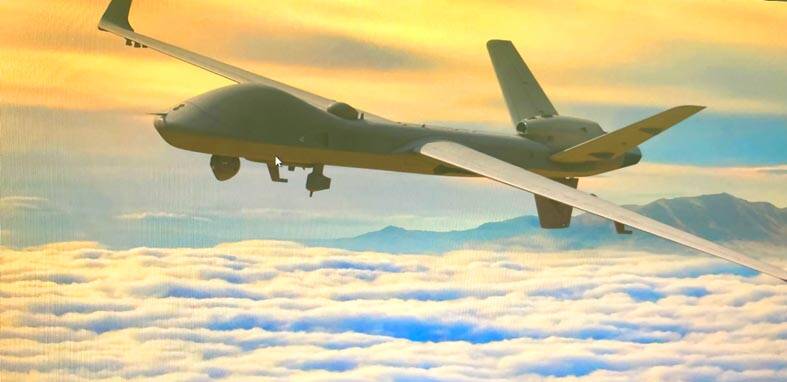Taiwan is to take delivery of two General Atomics MQ-9B SkyGuardian drones from the US in 2026 and another two by 2027, a US Air Force spokesperson said yesterday.
The spokesperson in an e-mail to the Central News Agency confirmed that Taiwan had purchased the four drones, two mobile ground control systems and related equipment from the US for US$467 million.
The purchase was approved by Washington in November 2020 and the contract was delivered to General Atomics Aeronautical Systems Inc in May last year, for completion by May next year.

Photo: screen grab from the General Atomic Aeronautical Web site
The US Department of Defense released a statement about the four-year-old deal last week, leading some media to mistakenly report that Taiwan had purchased another four SkyGuardian drones.
The US Defense Security Cooperation Agency’s 2020 announcement of the sale said that the drones would help Taiwan by “providing timely intelligence, surveillance and reconnaissance; target acquisition; and counter-land, counter-sea and anti-submarine strike capabilities for its security and defense.”
Based on a notice sent from the department to the US Congress, the drones are to be equipped with a maritime monitoring and positioning system, leading to speculation that Taipei purchased the SeaGuardian variation of the drone, Cato Institute senior fellow Eric Gomez said yesterday.
Regardless of which type, the MQ-9B drone can fly for long periods at high altitudes, Gomez said.
This makes it ideal for continuous surveillance during peacetime, helping to reduce Taiwan’s reliance on fighter jets, he said.
However, it can easily be spotted and shot down at high altitudes, making it less useful in a high-intensity conflict, he added.
Meanwhile, the US has assured Taiwan that FIM-92 Stinger man-portable air-defense systems would not be delayed with a goal of delivering them by next year, a Taiwanese military source said, speaking on condition of anonymity and citing the latest US status reports.
The US had been dragging its feet on the delivery of the systems since 2021, while the Ministry of National Defense had, as of October last year, sent 11 letters requesting that Washington expedite the delivery of the systems, the source said.
Taiwan had also lodged two formal complaints with the US Defense Security Cooperation Agency, and asked that the US replace the project manager, they said.
A Ministry of National Defense budget showed that Army Command Headquarters had set aside NT$7.26 billion (US$227.81 million), covering 2019 to next year, for 250 Stinger missiles, 108 gripstock-control groups — which attach to a shoulder-fired guided missile launch tube — and 108 identification friend or foe transponders.
Navy Command Headquarters has allotted NT$6.19 billion from 2017 to next year for 250 Stinger missiles, 70 gripstock-control groups and 62 transponders.
Capital defense units, such as the military police, the Marine Corps and the army’s special forces units, were prioritized to receive the weapons, the source said.
Legislators across party lines expressed concern regarding the often-changing delivery dates for the Stinger missiles, saying they were afraid shipments might have been shifted to meet supply needs for Ukraine, the source said.
However, with the missile components in production, it is less likely that delivery dates would be changed again, they said.
The US is holding regular meetings on missile production, and the ministry has dispatched representatives to ensure that this batch of Stinger missiles is delivered on time, they said.

The US government has signed defense cooperation agreements with Japan and the Philippines to boost the deterrence capabilities of countries in the first island chain, a report by the National Security Bureau (NSB) showed. The main countries on the first island chain include the two nations and Taiwan. The bureau is to present the report at a meeting of the legislature’s Foreign Affairs and National Defense Committee tomorrow. The US military has deployed Typhon missile systems to Japan’s Yamaguchi Prefecture and Zambales province in the Philippines during their joint military exercises. It has also installed NMESIS anti-ship systems in Japan’s Okinawa

TRAGEDY STRIKES TAIPEI: The suspect died after falling off a building after he threw smoke grenades into Taipei Main Station and went on a killing spree in Zhongshan A 27-year-old suspect allegedly threw smoke grenades in Taipei Main Station and then proceeded to Zhongshan MRT Station in a random killing spree that resulted in the death of the suspect and two other civilians, and seven injured, including one in critical condition, as of press time last night. The suspect, identified as a man surnamed Chang Wen (張文), allegedly began the attack at Taipei Main Station, the Taipei Fire Department said, adding that it received a report at 5:24pm that smoke grenades had been thrown in the station. One man in his 50s was rushed to hospital after a cardiac arrest

ON ALERT: Taiwan’s partners would issue warnings if China attempted to use Interpol to target Taiwanese, and the global body has mechanisms to prevent it, an official said China has stationed two to four people specializing in Taiwan affairs at its embassies in several democratic countries to monitor and harass Taiwanese, actions that the host nations would not tolerate, National Security Bureau (NSB) Director-General Tsai Ming-yen (蔡明彥) said yesterday. Tsai made the comments at a meeting of the legislature’s Foreign Affairs and National Defense Committee, which asked him and Minister of National Defense Wellington Koo (顧立雄) to report on potential conflicts in the Taiwan Strait and military preparedness. Democratic Progressive Party (DPP) Legislator Michelle Lin (林楚茵) expressed concern that Beijing has posted personnel from China’s Taiwan Affairs Office to its

PUBLIC SAFETY: The premier said that security would be tightened in transport hubs, while President Lai commended the public for their bravery The government is to deploy more police, including rapid response units, in crowded public areas to ensure a swift response to any threats, President William Lai (賴清德) said yesterday after a knife attack killed three people and injured 11 in Taipei the previous day. Lai made the remarks following a briefing by the National Police Agency on the progress of the investigation, saying that the attack underscored the importance of cooperation in public security between the central and local governments. The attack unfolded in the early evening on Friday around Taipei Main Station’s M7 exit and later near the Taipei MRT’s Zhongshan